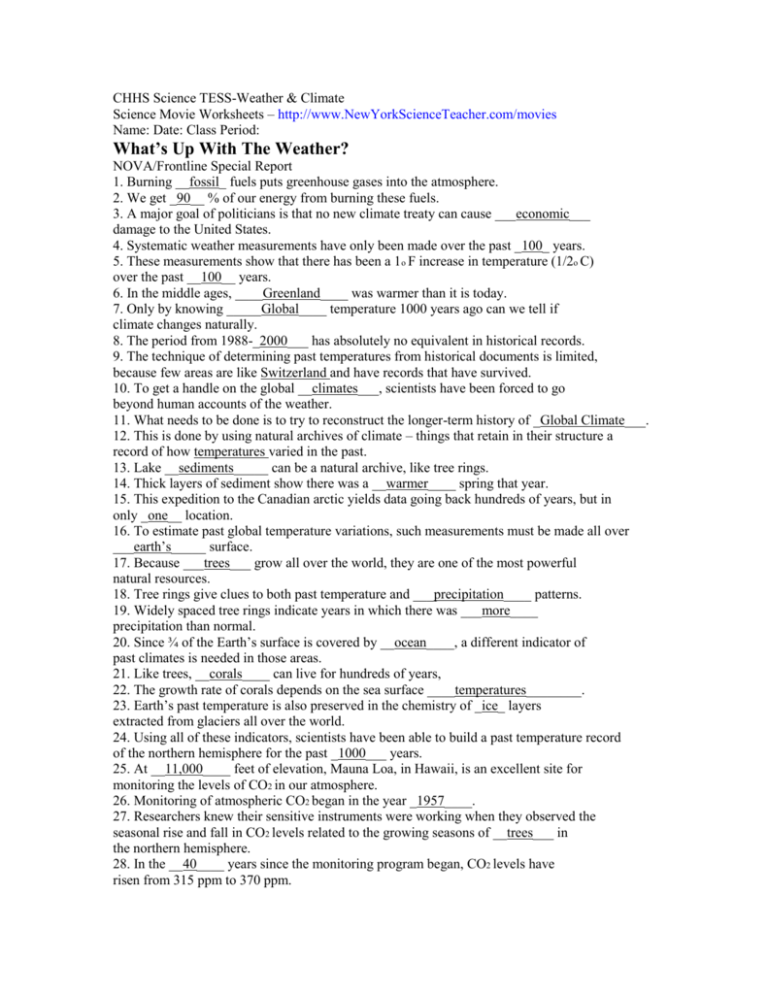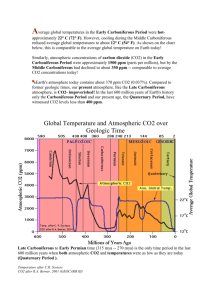CHHS Science TESS-Weather & Climate
advertisement

CHHS Science TESS-Weather & Climate Science Movie Worksheets – http://www.NewYorkScienceTeacher.com/movies Name: Date: Class Period: What’s Up With The Weather? NOVA/Frontline Special Report 1. Burning __fossil_ fuels puts greenhouse gases into the atmosphere. 2. We get _90__ % of our energy from burning these fuels. 3. A major goal of politicians is that no new climate treaty can cause ___economic___ damage to the United States. 4. Systematic weather measurements have only been made over the past _100_ years. 5. These measurements show that there has been a 1o F increase in temperature (1/2o C) over the past __100__ years. 6. In the middle ages, ____Greenland____ was warmer than it is today. 7. Only by knowing _____Global____ temperature 1000 years ago can we tell if climate changes naturally. 8. The period from 1988-_2000___ has absolutely no equivalent in historical records. 9. The technique of determining past temperatures from historical documents is limited, because few areas are like Switzerland and have records that have survived. 10. To get a handle on the global __climates___, scientists have been forced to go beyond human accounts of the weather. 11. What needs to be done is to try to reconstruct the longer-term history of _Global Climate___. 12. This is done by using natural archives of climate – things that retain in their structure a record of how temperatures varied in the past. 13. Lake __sediments_____ can be a natural archive, like tree rings. 14. Thick layers of sediment show there was a __warmer____ spring that year. 15. This expedition to the Canadian arctic yields data going back hundreds of years, but in only _one__ location. 16. To estimate past global temperature variations, such measurements must be made all over ___earth’s_____ surface. 17. Because ___trees___ grow all over the world, they are one of the most powerful natural resources. 18. Tree rings give clues to both past temperature and ___precipitation____ patterns. 19. Widely spaced tree rings indicate years in which there was ___more____ precipitation than normal. 20. Since ¾ of the Earth’s surface is covered by __ocean____, a different indicator of past climates is needed in those areas. 21. Like trees, __corals____ can live for hundreds of years, 22. The growth rate of corals depends on the sea surface ____temperatures________. 23. Earth’s past temperature is also preserved in the chemistry of _ice_ layers extracted from glaciers all over the world. 24. Using all of these indicators, scientists have been able to build a past temperature record of the northern hemisphere for the past _1000___ years. 25. At __11,000____ feet of elevation, Mauna Loa, in Hawaii, is an excellent site for monitoring the levels of CO2 in our atmosphere. 26. Monitoring of atmospheric CO2 began in the year _1957____. 27. Researchers knew their sensitive instruments were working when they observed the seasonal rise and fall in CO2 levels related to the growing seasons of __trees___ in the northern hemisphere. 28. In the __40____ years since the monitoring program began, CO2 levels have risen from 315 ppm to 370 ppm. 29. If the Earth had no greenhouse gases, the average global temperature would be _0_F_. 30. Since we do have CO2, methane, water vapor, and clouds, average global temperature is a balmy ___59_F_. 31. Since the industrial revolution, there has been a new and growing source of CO2 – __Fossil____ fuels like coal, oil, and natural gas. 32. At the end of WWII, 1 billion metric tons of CO2 were put in the atmosphere every year. By 1957 this had risen to 2 ½ billion metric tons. Now it is almost _7__. 33. Unlike water vapor, which stays in the atmosphere a few __days__, CO2 stays in the atmosphere for 100 years. 34. Ice cores from Antarctica show CO2 levels from the past in trapped air bubbles. 35. CO2’s rapid rise began at the beginning of the industrial revolution. Current CO2 levels are the highest they’ve been in the past 450 ___thousand years. 36. In ________ years CO2 concentration will be double the current levels. 37. In a huge experiment, CO2 concentrations in an actual forest were doubled. Two years into the experiment researchers observed a ________ percent growth rate increase.









